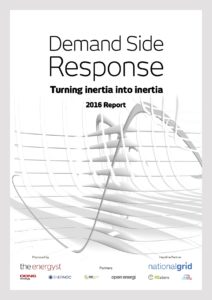 Dong Energy managing director of sales, Jeff Whittingham, believes the value of electricity loadshifting will increase significantly over the next five years. As such, he warned provider companies not to lock themselves into specific demand-side response (DSR) schemes.
Dong Energy managing director of sales, Jeff Whittingham, believes the value of electricity loadshifting will increase significantly over the next five years. As such, he warned provider companies not to lock themselves into specific demand-side response (DSR) schemes.
Whittingham told delegates at the DSR Event in London that Dong had entered the demand-response market because of changes to imbalance price rules, known as cash-out arrangements, that came into force last November.
Those changes make it more expensive for trading parties such as suppliers and generators if they have too much or too little power in the market at gate closure and are ‘out of balance’ (see this guide for explanation). As a result, Dong wants to pay companies to shift loads or switch to onsite generation if it is cheaper than paying the resulting imbalance penalty, which Whittingham said was likely to become “spikier” over the next few years.
While most demand-response revenues accrue from National Grid paying companies, usually via aggregators, to help balance the system, Whittingham said the imbalance issue opened up a “completely new profit pool” for businesses that can provide flexibility. “Only suppliers [as opposed to aggregators] can play in that space”, said Whittingham.
“You need a supply business and a trading arm to do it. So that is a big profit pool that I think is going to be significant over the next three to five years.”
Whittingham added that, “the value of the kilowatt is going to rapidly increase in the next three to five years” due to the rapidly changing UK generation mix and changes to the balancing market.
Louis Burford, vice president of aggregator Restore’s UK operation, agreed that the opportunity for monetising flexible use of power was bigger than demand-side response – but said sophisticated aggregators were already starting to operate within wholesale and balancing markets to maximise the value of customers’ flexibility.
“The value [of a kilowatt] is on the increase,” said Burford. “As time goes on, we will open up new markets that will increase the value of that megawatt or kilowatt.”
However, he admitted that for energy managers to work out how to forecast and maximise revenues, “it is a really complex area”.
While both Burford and Whittingham believe prices paid for flexibility will increase, Eamonn Boland, manager at consultancy Baringa Partners, suggested that an influx of competing providers, such as battery storage operators, may potentially create downward pressure on prices.
Such an outcome underlined the need to avoid committing to one particular DSR scheme, according to the panel.
“You have to be flexible with your flexibility,” said Whittingham.
“There will be all sorts of new schemes appearing: one of them will be helping suppliers with the balancing mechanism; some of them will be helping the distribution networks balance local grids; some of them will come from National Grid. So you need to be very careful about going too long in the marketplace and locking yourself into a price. Because if, as we believe, [prices in] this market will go up, you might not be getting best value for your flexibility. So be careful where you stick it.”
Restore’s Burford agreed.
“I couldn’t have put it better,” said Burford. “In order to get best value for your megawatt, you have to be agnostic in how you approach all the different revenue streams and not commit it to one specific programme.”
 Baringa, Dong and Restore offer more detailed views of the demand-side response market in our new 2016 DSR report. The report also contains the views of more than 200 end-users as well as other suppliers, aggregators and National Grid. Download it here, free of charge.
Baringa, Dong and Restore offer more detailed views of the demand-side response market in our new 2016 DSR report. The report also contains the views of more than 200 end-users as well as other suppliers, aggregators and National Grid. Download it here, free of charge.
Related stories:
Free report: 2016 DSR market report
Trinity Mirror targets £1m revenue from demand response
National Grid says 2020 demand response target “totally achievable”, mulls longer contracts
Can National Grid hit its 2020 DSR target?
Aggregators: firms shouldn’t fear disruption from demand-side response
Fear of disruption hobbling demand response uptake
More than half of I&C firms mulling energy storage investment
Grid buys 201MW of enhanced frequency response
Battery storage: positive outlook?
Demand-side response: Give us your views
National Grid must provide a plan for battery market, says SmartestEnergy
Limejump boss: Big six will have to acquire aggregators or lose relevence
National Grid buys 3.6GW of back-up power to cover winter
Three policy tweaks that could enable 10GW of battery storage
Decc, Ofgem and National Grid must make battery storage stack-up
Ofgem: Energy flexibility will become more valuable than energy efficiency
National Grid boss: future of energy is demand not supply
National Grid says impact of solar requires greater system flexibility
National Grid signs 20MW demand-side response contract with battery storage operator
National Grid says UK will miss 2020 targets, predicts big battery future
Major changes to capacity market proposed
Hot technology: energy storage via heat battery
Western Power Distribution ramps up demand-response trials, calls for participants
Smart grids ‘require local control and businesses must play or pay’
National Grid must simplify demand response to scale UK market
Energy Technologies Institute: Let private firms run smartgrid trials
Flexitricity blasts transitional capacity market as Npower plots supermarket sweep
Follow us at @EnergystMedia. For regular bulletins, sign up for the free newsletter.



